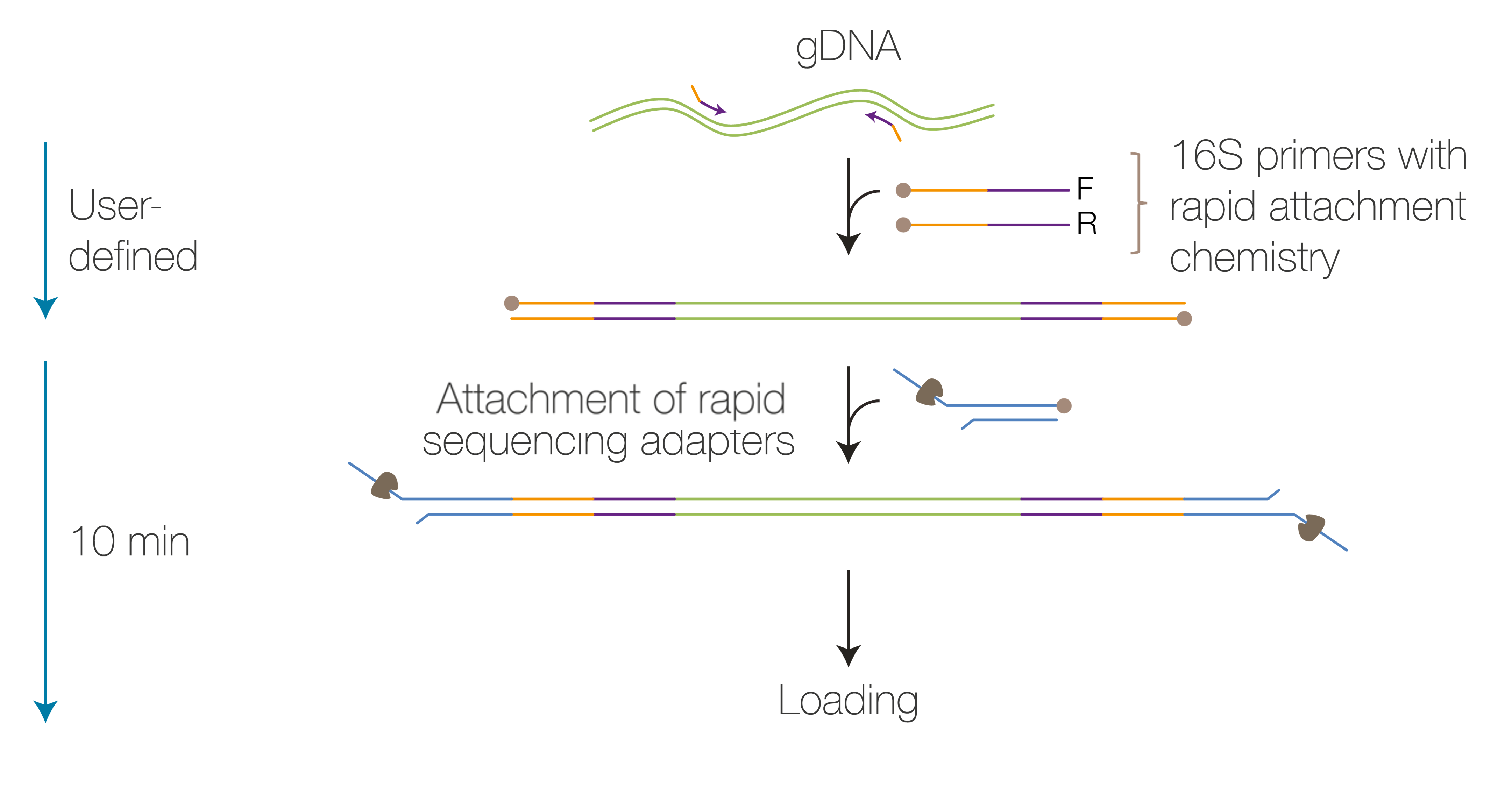Library Preparation and Sequencing Kits
Core Nanopore sequencing kits
While Oxford Nanopore offers a variety of kits and applications, we generally focus on sequencing strategies that use the following three Nanopore kits.
Nanopore account required to access
Some of the links require you to sign into you Oxford Nanopore account. You may obtain a free account by signing up: Register
16S Barcoding Kit 24 V14
The 16S Barcoding Kit 24 V14 is designed for rapid and efficient amplification and sequencing of the full-length 16S rRNA gene (~1,500 bp) from extracted genomic DNA (gDNA). This kit facilitates genus-level bacterial identification by targeting the 16S rRNA gene, a highly conserved region present in all bacteria, making it a valuable tool for microbial diversity studies.

Key Features
- Full-length amplification: Utilizes primers that amplify the entire 16S rRNA gene for accurate bacterial identification.
- Multiplexing: Includes 24 unique barcodes, allowing simultaneous sequencing of up to 24 different samples in a single run, enhancing throughput and reducing costs.
- Rapid library preparation: The protocol requires approximately 40 minutes plus PCR time (2-3 hours).
- Minimal input requirement: Requires only 10 ng of gDNA per sample, making it suitable for samples with limited DNA quantities.
- No fragmentation: Designed to work with intact gDNA without the need for fragmentation, simplifying the preparation process.
Applications
- Microbial community profiling: Ideal for analyzing complex microbial populations in environmental samples, or microbiome studies.
- Bacterial identification: Enables rapid identification of bacterial genera in mixed samples, aiding in diagnostics and research.
- Educational applications: Suitable for teaching laboratories to demonstrate sequencing techniques and microbial diversity analysis.
What you get (and what's not included)
The product page for all Nanopore kits has a "3RD Party Materials" section that describes all of the materials and reagents not included in the kit. Review this list ahead of time to ensure you have everything you need to perform the experiment.
Rapid Barcoding Kit 24 V14
The Rapid Barcoding Kit 24 V14 (SQK-RBK114.24) is designed for swift and straightforward preparation of up to 24 barcoded sequencing libraries without the need for PCR amplification. This kit employs a transposase enzyme to simultaneously fragment genomic DNA (gDNA) and attach unique barcoded tags, facilitating efficient multiplexing and sequencing.

Key Features:
- PCR-Free workflow: Enables direct sequencing of gDNA without PCR amplification, preserving base modifications and reducing preparation time.
- Multiplexing: Includes 24 unique barcodes, allowing simultaneous sequencing of up to 24 samples in a single run, enhancing throughput and cost-effectiveness.
- Rapid library preparation: The protocol requires approximately 60 minutes, streamlining the workflow for quick results.
- Minimal input: Requires only 200 ng of gDNA per sample, accommodating samples with limited DNA quantities.
To PCR or not to PCR
We also recommend this kit for DNA Barcoding (e.g. species identification using DNA); in that case, you will amplify a barcoding region (e.g., rbcL, COI) and using this kit to sequence the amplicon.
Applications:
- DNA Barcoding: Barcode regions amplified by PCR or other amplicons can quickly be sequenced using this kit. Because this kit fragments PCR products, you will need to use bioinformatics to reassemble fragments.
- Genomic DNA sequencing: Suitable for rapid sequencing of gDNA from various organisms, aiding in genomic studies and research.
- Microbial community analysis: Facilitates the study of complex microbial populations by enabling the sequencing of multiple samples concurrently.
Ligation Sequencing Kit V14
The Ligation Sequencing Kit V14 offers a flexible method for preparing sequencing libraries from double-stranded DNA (dsDNA), including genomic DNA (gDNA), complementary DNA (cDNA), or amplicons. The straightforward library preparation involves repairing DNA ends and adding a dA-tail using the NEBNext End Repair/dA-Tailing Module, followed by ligation of sequencing adapters provided in the kit.

Key Features:
- Versatile input compatibility: Suitable for various dsDNA inputs, such as gDNA, cDNA, or amplicons, providing flexibility across different applications.
- High accuracy: Optimized to deliver modal raw read accuracies over 99% (Q20+) when used with R10.4.1 nanopores, ensuring reliable sequencing data.
- Long read lengths: Capable of producing read lengths equivalent to the input fragment length, facilitating comprehensive genomic analyses.
- Preparation time: Approximately 120 minutes, streamlining the workflow for efficient library preparation.
- Input requirement: Requires 1,000 ng of dsDNA; for fragmented or PCR-amplified DNA, 100 ng or more is sufficient, and for amplicons or cDNA, 100–200 fmol is recommended.
Applications:
- Whole genome sequencing: Ideal for sequencing entire genomes, providing comprehensive coverage and high accuracy.
- Transcriptome analysis: Suitable for sequencing cDNA to study gene expression and alternative splicing events.
- Amplicon sequencing: Effective for sequencing PCR products, enabling targeted analysis of specific genomic regions.
Additional sequencing reagents
The sample prep product page features the entire line of kits. Some additional ones you may want to be aware of include:
- Native barcoding Kit: Similar to the ligation kit, allows you to barcode your ligated products (e.g., genomic DNA, amplicons)
- Flow cell wash kit: If you are using the MinION flow cell, you can use this kit to wash between uses, eliminating cross-contaminating DNA.
- Sequencing auxiliary vials: During your trials or if you are doing lots of sequencing, you may eventually find you have run out of some reagents and have extra of others. These are extra vials of common reagents, allowing you to have extra on hand.
- Rapid adapter auxiliary: If you are using kits with the rapid adaptor (e.g. 16s, rapid barcoding), this is the most expensive component and a limiting reagent. If you want extra, you may be able to pool and extend your kits.
Comments and discussion
See recent comments or start a discussion on our Slack channel.